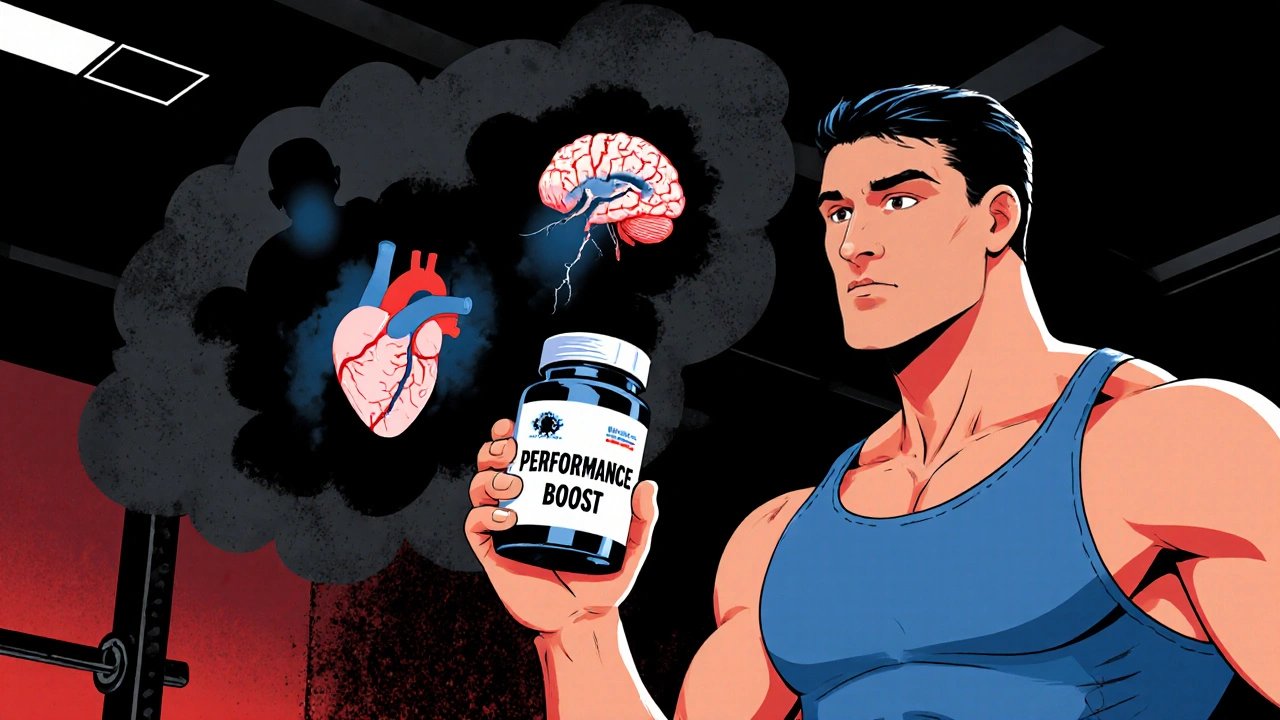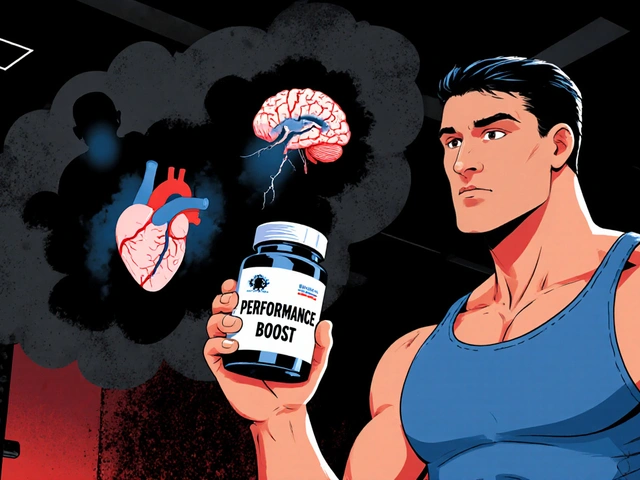PED Side Effects Checker
Check for Performance-Affecting Side Effects
Identify potential side effects from performance-enhancing drugs based on your symptoms. This tool is for informational purposes only.
When athletes turn to meds for a competitive edge, the short‑term boost often masks a cascade of hidden health problems. Understanding which drugs interfere with performance and why they do so is essential for anyone who lifts, runs, or competes at any level.
What counts as a performance‑enhancing drug?
Performance-enhancing drugs (PEDs) are substances taken to improve physical capabilities beyond natural limits. They range from anabolic steroids and stimulants to human growth hormone (hGH) and blood‑doping agents. First documented in the 1950s, PEDs have evolved from elite‑only tools to a mainstream fitness‑culture issue, with recreational gym users now comprising the bulk of misuse cases.
Major classes of drugs used by athletes
- Anabolic steroids - testosterone‑derived compounds that bind androgen receptors, driving protein synthesis and rapid muscle growth.
- Stimulants - amphetamines, ephedrine, and high‑dose caffeine that raise dopamine and norepinephrine, sharpening reaction time.
- Human growth hormone (hGH) - a peptide hormone injected daily to boost tissue repair and lean‑mass accrual.
- Blood doping - methods such as erythropoietin (EPO) or autologous transfusions that increase red‑blood‑cell count and aerobic capacity.
- Selective androgen receptor modulators (SARMs) - newer “designer” compounds marketed as safer alternatives but with limited safety data.
How these substances boost performance
Each drug class attacks a different physiological bottleneck:
- Anabolic steroids amplify muscle protein synthesis, delivering 10‑20% more muscle mass in 6‑12 weeks.
- Stimulants increase central nervous system firing, shaving 8‑12% off reaction times within 30 minutes of ingestion.
- hGH speeds collagen turnover, cutting recovery periods by roughly 30‑50%.
- Blood doping raises VO₂ max by 5‑15%, allowing athletes to sustain higher intensity for longer.
These gains are tempting, but the body pays a price. Below we break down the most common performance‑affecting side effects.
Key side effects by drug class
| Drug class | Cardiovascular impact | Hormonal disruption | Other notable risks |
|---|---|---|---|
| Anabolic steroids | ↑ cardiac mass (27‑45%); ↓ ejection fraction (8‑12%) | Suppressed testosterone → hypogonadism (<300 ng/dL) in 90% after 8 weeks | Liver enzyme elevation (68% oral users); permanent voice deepening in women (35%) |
| Stimulants | Elevated BP, arrhythmia risk; 2,000+ ED visits annually (U.S.) | Transient cortisol spikes; possible insomnia‑induced endocrine drift | Dependence, anxiety, severe jitteriness at >6 mg/kg caffeine |
| hGH | Cardiac wall thickening; potential for cardiomyopathy | Insulin‑like growth factor imbalance; can provoke acromegaly‑like changes | Joint pain, edema, increased cancer risk (theoretical) |
| Blood doping | Polycythemia → stroke risk 7‑fold when hematocrit >50% | Suppressed natural erythropoietin production after cessation | Viscosity‑related thrombosis; illegal transfusion complications |
| SARMs | Limited data; early reports of hypertension | Partial androgenic activity; may still suppress LH/FSH | Undeclared ingredients in 89% of market samples |
Notice how every class touches the heart, hormones, or both. The performance side effects that athletes chase are inseparable from these health hazards.
Real‑world statistics and case studies
Data from the University of Colorado (2023), the Mayo Clinic (2022), and the NHS (2023) paint a stark picture:
- 60‑80% of anabolic‑steroid misuse occurs in non‑competitive gym users.
- 73% of recreational users stack two or more compounds, dramatically increasing toxicity.
- Cardiovascular events rise 36% among AAS users, equating to an extra 10‑15 years of heart‑age.
- In a 2022 survey, 83% reported severe mood swings, and 67% experienced clinically significant depression during off‑cycles.
- Adolescent presentations of steroid‑induced cardiomyopathy jumped 200% between 2018‑2022.
These numbers are not just academic-they translate into torn tendons, infertility, and life‑threatening strokes for everyday athletes.
Medical community guidance
Experts agree on three core messages:
- Screening matters. Family physicians miss PED use in 7 out of 10 cases because patients hide it or the drugs lack classic lab flags.
- Monitoring is mandatory. Legitimate hormone‑replacement therapy requires quarterly blood work (LH, FSH, lipid profile, hematocrit). Recreational use rarely includes any follow‑up.
- Withdrawal needs supervision. Hormonal rebalancing can take 6‑12 months; 38% of chronic users develop permanent hypogonadism needing lifelong testosterone replacement.
Regulatory bodies such as the World Anti-Doping Agency (WADA) have tightened the Prohibited List (2023), adding three new SARMs and tightening therapeutic‑use exemption (TUE) criteria. Yet only 0.7% of the 250,000 annual tests return positive for anabolic agents, suggesting a massive detection gap.

How to spot performance‑affecting side effects early
Watch for these red flags during a training cycle:
- Sudden, unexplained spikes in blood pressure or resting heart rate.
- Rapid weight gain without a clear diet change (often fluid retention).
- Persistent mood swings, irritability, or depressive episodes.
- Reduced libido, testicular atrophy, or menstrual irregularities.
- Unusual muscle‑tendon injuries-strength outpaces connective‑tissue adaptation.
If any appear, a full metabolic panel, echocardiogram, and hormone panel become essential.
Prevention and safe practice recommendations
For athletes who want to stay clean and still optimize performance, follow these evidence‑based steps:
- Prioritize nutrition and sleep. Adequate protein (1.6‑2.2 g/kg) and 7-9 hours of sleep are proven to support natural hypertrophy.
- Use periodized training. Structured overload and deload weeks reduce over‑use injuries without chemicals.
- Consider legal supplements. Creatine monohydrate, beta‑alanine, and caffeine (< 3 mg/kg) have strong safety records.
- Engage a sports‑medicine professional. Baseline cardiac echo and hormone labs before any new regimen.
- Stay informed about rule changes. WADA updates the Prohibited List annually; a quick glance at the 2024 version can prevent accidental doping.
Remember, the smallest shortcut can become a lifelong health problem.
Key takeaways for athletes, coaches, and clinicians
In a nutshell:
- PEDs deliver measurable performance boosts, but every class carries serious cardiovascular, hormonal, or metabolic side effects.
- Recreational misuse now outweighs elite doping-most users hide their consumption from doctors.
- Early detection hinges on routine medical screening and awareness of subtle physiological changes.
- Safe performance improvement rests on evidence‑based training, nutrition, and legally vetted supplements.
Choosing health over a temporary edge is the only sustainable path to a long, injury‑free athletic career.
What are the most common side effects of anabolic steroids for athletes?
Anabolic steroids can cause heart enlargement, reduced ejection fraction, liver enzyme spikes, testosterone suppression (often leading to infertility), permanent voice changes in women, and severe acne. The risk rises with higher doses and longer cycles.
Can legal supplements like caffeine cause performance‑affecting side effects?
At moderate doses (up to 3 mg/kg), caffeine boosts alertness with minimal risk. Exceeding 6 mg/kg can trigger heart palpitations, anxiety, and sleep disruption, which may indirectly harm performance.
How does blood doping affect VO₂ max and what are its dangers?
Blood doping raises red‑blood‑cell mass, boosting VO₂ max by 5‑15 %. However, it thickens blood, increasing the chance of clot‑related strokes; hematocrit above 50 % raises stroke risk seven‑fold.
Are SARMs safer than traditional anabolic steroids?
SARMs were marketed as selective, but 89 % of tested products contain undeclared compounds, and long‑term safety data are lacking. They still suppress natural hormones and can cause liver stress.
What should an athlete do if they suspect they’ve experienced side effects from a PED?
Stop the substance immediately, seek a sports‑medicine doctor, and request a full cardiac echo, hormone panel, and liver‑kidney function tests. A structured post‑cycle therapy plan can aid recovery.



Brett Witcher
October 24, 2025 AT 19:11The pharmacological mechanisms underlying anabolic steroids reveal a cascade of anabolic and androgenic pathways that are meticulously calibrated to augment protein synthesis.
When exogenous testosterone analogues bind to intracellular receptors, they up‑regulate transcription of genes responsible for myofibrillar growth.
This results in measurable hypertrophy, often quantified as a 10‑20% increase in lean mass over a twelve‑week cycle.
However, the concomitant elevation of erythropoietin and lipid oxidation imposes a substantial burden on myocardial oxygen demand.
Cardiac remodeling ensues, manifesting as concentric hypertrophy and a reduced ejection fraction, metrics that are predictive of future heart failure.
Endocrinologically, negative feedback suppresses the hypothalamic‑pituitary‑gonadal axis, precipitating hypogonadism and, in chronic users, irreversible Leydig cell atrophy.
Hepatotoxicity is another well‑documented sequela, particularly with 17‑α‑alkylated oral formulations that impede bile flow.
The liver enzyme profile often exhibits a striking elevation of ALT and AST, foreshadowing cholestatic injury.
Moreover, the pro‑thrombotic state induced by altered lipid panels-elevated LDL and diminished HDL-augments the risk of atherogenesis.
Psychologically, the abrupt oscillation of steroid cycling can destabilize mood regulation, leading to irritability, aggression, and depressive episodes during off‑cycles.
These neuropsychiatric manifestations are not merely anecdotal; meta‑analyses report a prevalence of mood disturbances approaching 70% among chronic users.
From a nephrological perspective, renal glomerular hyperfiltration may progress to proteinuria, a subtle yet clinically relevant marker of renal stress.
Immunologically, exogenous steroids dampen cytotoxic T‑cell activity, rendering users more susceptible to opportunistic infections.
In the context of blood doping, increased hematocrit amplifies blood viscosity, thereby elevating the probability of thromboembolic events, including ischemic stroke.
Finally, the ethical ramifications of concealed substance use erode the trust between athlete and medical practitioner, complicating accurate diagnosis and timely intervention.
Collectively, these multidimensional risks underscore the imperative for rigorous screening, continuous monitoring, and comprehensive post‑cycle therapy.
Benjamin Sequeira benavente
October 25, 2025 AT 20:11Crush your limits, but never at the expense of your heart or hormones – stay sharp, stay safe, and keep grinding forward!
Shannon Stoneburgh
October 26, 2025 AT 18:24The risks outweigh any short‑term gains. Simple as that.
Nathan Comstock
October 27, 2025 AT 13:51Patriotic athletes should defend their bodies, not sabotage them; the nation’s strength lies in healthy citizens, not chemically‑enhanced shortcuts.
Terell Moore
October 28, 2025 AT 06:31Ah, yet another manifesto warning us about the perils of shortcuts, as if the complexities of human physiology could be reduced to a bullet‑point list.
Amber Lintner
October 28, 2025 AT 20:24Actually, the nuance is lost when you paint every PED with the same brush; some compounds have manageable profiles when used responsibly.
Lennox Anoff
October 29, 2025 AT 07:31We must confront the moral bankruptcy of a culture that glorifies instant gratification over enduring health.
The glorification of chemical enhancement erodes the very foundation of fair competition.
Every illicit dose is a betrayal of the athlete’s pledge to themselves and to their community.
It is incumbent upon us, as informed participants, to reject these temptations and champion genuine effort.
Olivia Harrison
October 29, 2025 AT 17:14That’s a solid point – if you ever notice unexplained spikes in blood pressure or mood swings, it’s wise to get a full check‑up and talk openly with a sports‑medicine professional.
Bianca Larasati
October 30, 2025 AT 01:34Stay clean, stay strong!
ram kumar
October 30, 2025 AT 08:31Sure, but the market will always find a loophole, so education alone can’t stop misuse.
Ken Dany Poquiz Bocanegra
October 30, 2025 AT 14:04One wonders whether the pursuit of performance eclipses the essence of sport.
Tamara Schäfer
October 30, 2025 AT 19:04i think itz importent to ask the question, how do we definie 'fair' in a world of chemicall advantage?
Tamara Tioran-Harrison
October 30, 2025 AT 23:31It is, of course, utterly surprising that the elite continue to experiment with substances whose long‑term sequelae are still under investigation.
kevin burton
October 31, 2025 AT 03:24The recommendation to monitor hormone levels remains prudent.
Max Lilleyman
October 31, 2025 AT 06:44If you ignore these warnings, expect a heart attack sooner rather than later. 😐